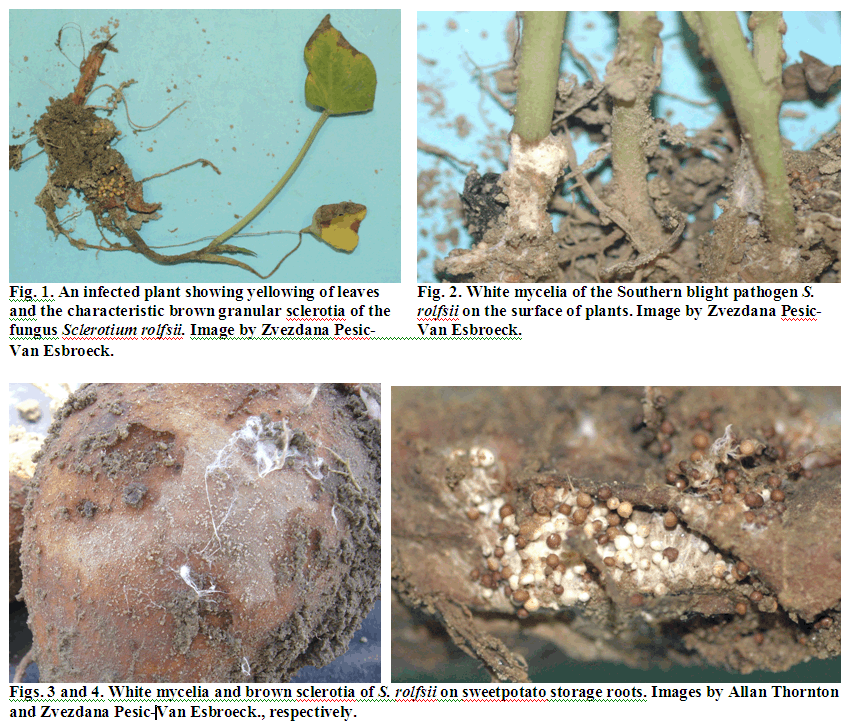Southern Blight in Sweetpotato Plant Beds
go.ncsu.edu/readext?283026
en Español / em Português
El inglés es el idioma de control de esta página. En la medida en que haya algún conflicto entre la traducción al inglés y la traducción, el inglés prevalece.
Al hacer clic en el enlace de traducción se activa un servicio de traducción gratuito para convertir la página al español. Al igual que con cualquier traducción por Internet, la conversión no es sensible al contexto y puede que no traduzca el texto en su significado original. NC State Extension no garantiza la exactitud del texto traducido. Por favor, tenga en cuenta que algunas aplicaciones y/o servicios pueden no funcionar como se espera cuando se traducen.
Português
Inglês é o idioma de controle desta página. Na medida que haja algum conflito entre o texto original em Inglês e a tradução, o Inglês prevalece.
Ao clicar no link de tradução, um serviço gratuito de tradução será ativado para converter a página para o Português. Como em qualquer tradução pela internet, a conversão não é sensivel ao contexto e pode não ocorrer a tradução para o significado orginal. O serviço de Extensão da Carolina do Norte (NC State Extension) não garante a exatidão do texto traduzido. Por favor, observe que algumas funções ou serviços podem não funcionar como esperado após a tradução.
English
English is the controlling language of this page. To the extent there is any conflict between the English text and the translation, English controls.
Clicking on the translation link activates a free translation service to convert the page to Spanish. As with any Internet translation, the conversion is not context-sensitive and may not translate the text to its original meaning. NC State Extension does not guarantee the accuracy of the translated text. Please note that some applications and/or services may not function as expected when translated.
Collapse ▲Zvezdana Pesic-Van Esbroeck, Department of Plant Pathology, Jonathan Schultheis and Allan Thornton, Department of Horticultural Science, and Billy Little, North Carolina Cooperative Extension Service, Wilson County Center
Southern blight (also known as the Sclerotial blight) caused by the fungus Sclerotium rolfsii can cause a sudden wilt, death of sprouts and melt down of storage roots. The extent of damage ranges from small tire size dead spots to the loss of entire beds.
Economic importance, host range and distribution
Southern blight caused by the fungus S. rolfsii is a serious fungal disease affecting a wide variety of both food crops and ornamental plants. At least 500 species in 100 families are susceptible to S. rolfsii. The hosts include sweetpotato, soybean, corn, bean, peanut, cotton, tomato, bell pepper, potato, wheat, cucumber, tobacco and other crops. It occurs in sweetpotato almost exclusively in plant production beds and may be very destructive under warm and humid conditions that stress plants thus making them susceptible to the pathogen.
Causal organism
The fungus S. rolfsii is characterized by the production of rapidly growing white mycelium and the yellow to brown mustard seed-like sclerotia that serve as survival structures and are produced on the mycelium (Figs. 1-4).

Disease cycle
The fungus S. rolfsii overwinters as a sclerotium, which is a dense mass of hyphae with a hard outer shell. When warm (82 to 86 degrees F), humid conditions are present the sclerotia “germinate” and grow on senescent leaves on the soil surface, then they invade seed roots and the developing sprouts. On the seed roots S. rolfsii causes a soft rot, when it invades the developing sprouts at the point they emerge from the seed root it causes them to wilt and die. The sclerotia are produced on the mycelium on both seed roots and plant stems. The pathogen survives in the soil for several years in plant residues in the upper 4 inches. It spreads by the mycelium growing on the soil surface, by sclerotia, surface water or by mechanical means.
Disease management
Site selection. Choose a well-drained site for the plant bed that has not had sweetpotatoes for at least 3 to 4 years. It is also important to be sure that S. rolfsii has not been a problem on the rotational crops.
Plant handling. Cut plants in beds 1 inch above the soil line. Do not pull plants. Use disease-free planting stock.
Removal of bed covers. If covers are left in place too long after the plants emerge, the leaves of emerging sprouts may be seriously injured by excess heat and serve as a source of nutrients for the pathogen. Therefore, to minimize the occurrence of Southern blight, bed covers should be removed as soon as the sprouts emerge from seed roots.
Deep plowing. The sclerotia do not survive when buried at least 8 inches into soil with a breaking plow.
Solarization. Prior to establishing seedbeds, the soil may be covered with black polyethylene sheets for a 6 week period during the hottest months of the year. The top soil layers become very hot, effectively controlling the fungus.
Chemical control. Dipping roots prior to bedding, or to a lesser extent, spraying roots laid out in beds with a protectant fungicide such as dichloran (Botran) can reduce the incidence of Southern blight. The fungicide acts primarily by protecting the points where sprouts emerge from seed roots, which are a favored site for infection. The fungicide is less effective when the fungus infects sprouts closer to the soil line.
Make in-furrow or banded applications with azoxystrobin (Quadris) shortly after transplanting. Drenching the beds with Quadris at 15.4 ounces per acre using a minimum of 35 gallons of water may provide some suppression of Southern blight in plant beds.
Soil fumigation with chloropicrin can aid in reducing inoculum and Southern blight incidence.


